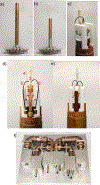Modular, triple-resonance, transmission line DNP MAS probe for 500 MHz/330 GHz
- PMID: 31505305
- PMCID: PMC6766420
- DOI: 10.1016/j.jmr.2019.106573
Modular, triple-resonance, transmission line DNP MAS probe for 500 MHz/330 GHz
Abstract
We describe the design and construction of a modular, triple-resonance, fully balanced, DNP-MAS probe based on transmission line technology and its integration into a 500 MHz/330 GHz DNP-NMR spectrometer. A novel quantitative probe design and characterization strategy is developed and employed to achieve optimal sensitivity, RF homogeneity and excellent isolation between channels. The resulting three channel HCN probe has a modular design with each individual, swappable module being equipped with connectorized, transmission line ports. This strategy permits attachment of a mating connector that facilitates accurate impedance measurements at these ports and allows characterization and adjustment (e.g. for balancing or tuning/matching) of each component individually. The RF performance of the probe is excellent; for example, the 13C channel attains a Rabi frequency of 280 kHz for a 3.2 mm rotor. In addition, a frequency tunable 330 GHz gyrotron operating at the second harmonic of the electron cyclotron frequency was developed for DNP applications. Careful alignment of the corrugated waveguide led to minimal loss of the microwave power, and an enhancement factor ε = 180 was achieved for U-13C urea in the glassy matrix at 80 K. We demonstrated the operation of the system with acquisition of multidimensional spectra of cross-linked lysozyme crystals which are insoluble in glycerol-water mixtures used for DNP and samples of RNA.
Keywords: Balanced transmission line probe; NMR probe characterization; Novel probe design; Solid state DNP.
Copyright © 2019 Elsevier Inc. All rights reserved.
Figures

















Similar articles
-
A spectrometer designed for 6.7 and 14.1 T DNP-enhanced solid-state MAS NMR using quasi-optical microwave transmission.J Magn Reson. 2012 Feb;215:1-9. doi: 10.1016/j.jmr.2011.12.006. Epub 2011 Dec 11. J Magn Reson. 2012. PMID: 22218011
-
Solid-state dynamic nuclear polarization at 263 GHz: spectrometer design and experimental results.Phys Chem Chem Phys. 2010 Jun 14;12(22):5850-60. doi: 10.1039/c003685b. Epub 2010 May 7. Phys Chem Chem Phys. 2010. PMID: 20449524 Free PMC article.
-
250GHz CW gyrotron oscillator for dynamic nuclear polarization in biological solid state NMR.J Magn Reson. 2007 Dec;189(2):251-79. doi: 10.1016/j.jmr.2007.09.013. Epub 2007 Sep 20. J Magn Reson. 2007. PMID: 17942352 Free PMC article.
-
DNP NMR of biomolecular assemblies.J Struct Biol. 2019 Apr 1;206(1):90-98. doi: 10.1016/j.jsb.2018.09.011. Epub 2018 Sep 29. J Struct Biol. 2019. PMID: 30273657 Review.
-
Recent developments in MAS DNP-NMR of materials.Solid State Nucl Magn Reson. 2019 Sep;101:116-143. doi: 10.1016/j.ssnmr.2019.05.009. Epub 2019 May 27. Solid State Nucl Magn Reson. 2019. PMID: 31189121 Review.
Cited by
-
A complete 3D-printed tool kit for Solid-State NMR sample and rotor handling.J Magn Reson. 2024 Sep;366:107748. doi: 10.1016/j.jmr.2024.107748. Epub 2024 Aug 6. J Magn Reson. 2024. PMID: 39178738 Free PMC article.
-
Second Harmonic 527-GHz Gyrotron for DNP-NMR: Design and Experimental Results.IEEE Trans Electron Devices. 2020 Jan;67(1):328-334. doi: 10.1109/ted.2019.2953658. Epub 2019 Dec 10. IEEE Trans Electron Devices. 2020. PMID: 32099264 Free PMC article.
-
3D-printed stators & drive caps for magic-angle spinning NMR.J Magn Reson. 2022 Feb;335:107126. doi: 10.1016/j.jmr.2021.107126. Epub 2021 Dec 10. J Magn Reson. 2022. PMID: 34954545 Free PMC article.
-
Conformation of bis-nitroxide polarizing agents by multi-frequency EPR spectroscopy.Phys Chem Chem Phys. 2018 Oct 10;20(39):25506-25517. doi: 10.1039/c8cp05236k. Phys Chem Chem Phys. 2018. PMID: 30277229 Free PMC article.
References
-
- Becerra LR, Gerfen GJ, Temkin RJ, Singel DJ, Griffin RG, Dynamic Nuclear Polarization with a Cyclotron Resonance Maser at 5 T, Phys Rev Lett, 71 (1993) 3561–3564. - PubMed
-
- Gerfen GJ, Becerra LR, Hall DA, Griffin RG, Temkin RJ, Singel DJ, High-Frequency (140 GHz) Dynamic Nuclear-Polarization - Polarization Transfer to a Solute in Frozen Aqueous-Solution, J Chem Phys, 102 (1995) 9494–9497.
-
- Hall DA, Maus DC, Gerfen GJ, Inati SJ, Becerra LR, Dahlquist FW, Griffin RG, Polarization-Enhanced NMR Spectroscopy of Biomolecules in Frozen Solution, Science, 276 (1997) 930–932. - PubMed
-
- Lee D, Bouleau E, Saint-Bonnet P, Hediger S, De Paepe G, Ultra-low temperature MAS-DNP, J Magn Reson, 264 (2016) 116–124. - PubMed
Publication types
MeSH terms
Substances
Grants and funding
LinkOut - more resources
Full Text Sources

